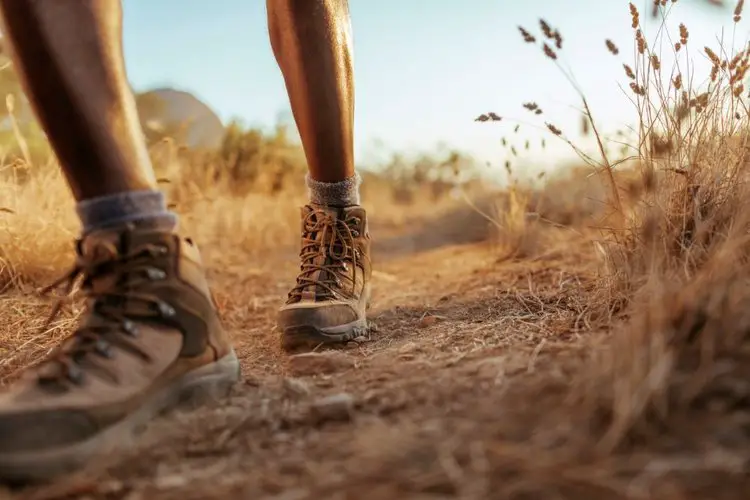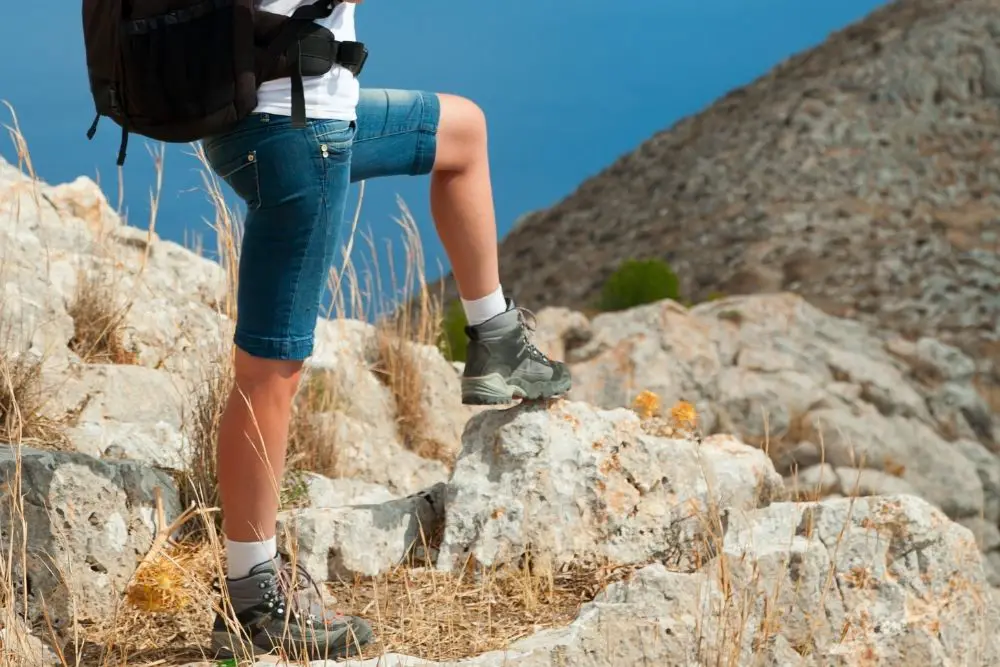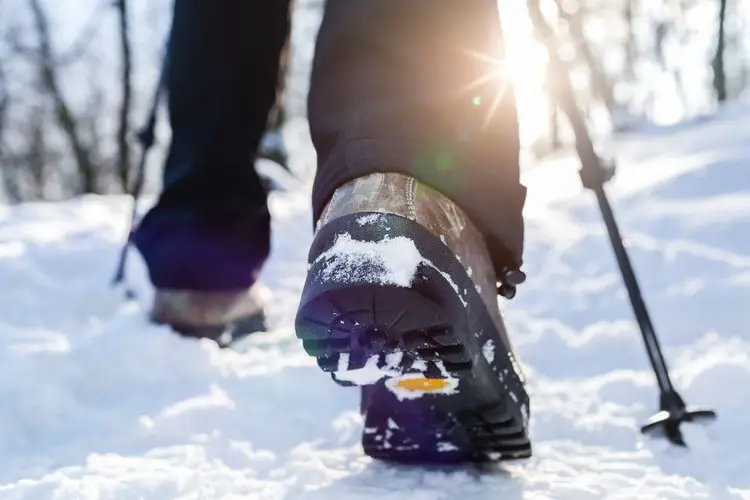The choice of how high or low a hiking boot should be is personal. Manufacturers understand this and are churning out a large diversity of boots to satisfy the taste of different hikers. However, environmental factors can also influence the height of hiking boots that you should wear.
The height of hiking boots can vary from low to mid-cut or high-cut. These are terms used to describe the height of the upper part of the hiking boots in relation to the ankle.
The low-cut hiking boots sit below the ankle while the mid-cut extends just above the ankle. High-cut hiking boots stretch all the way above the ankle and up to the base of the shin.
When people ask us how high hiking boots should be, our answer is simple, it depends—on a number of factors. What may feel right for one hiker in Joshua Tree may be a terribly wrong idea for another in Haleakala National Park.
Is there a standard height for hiking boots? What are the considerations every hiker must make when choosing hiking boot height? We will provide all the answers that you need below.
Contents
How high should hiking boots be?
If your hiking route is a paved trail with a clear path, you have no need to complicate things when choosing a hiking boot. A low-cut hiking boot will be just fine, right?
Well, in an ideal case, that should be an easy and straightforward answer. However, when the weather is really cold like during the winter peaks, you may still need to go for high-cut hiking boots with crampons to properly keep your feet warm and your grip firm.
It is important to mention that all hiking boots’ heights have their pros and cons. For example, the low-cut hiking boots sit just below the ankle, thereby allowing your ankles to move freely.

They are also lighter than the high-cut hiking boots. This will come in handy when you hike a terrain where you have to scale rocks.
The downside of this type of boots is that they provide little or no ankle support—and this is the main reason most hardcore hikers tend to keep them on the sideline when making their choice.
High-cut hiking boots are usually heavier but provide adequate protection and support for the ankles so that you don’t graze them against a sharp rock or twig or twist them. That is why you have to make your choice carefully.
Below are all the considerations you should make when choosing how high your hiking boots should be.
Consider your weight and the your backpack’s weight
Every hiking boot has a weight rating which you can easily read off the package or the labels on the boots. Inasmuch as nobody will send you to jail for using a pair of hiking boots below your weight, you will just be setting them up for their untimely demise.
The weight of your backpack is another factor to consider when choosing hiking boots. In other words, before you choose a hiking boot make sure you add the tentative weight of your backpack.

For example, let us say that you picked a pair of hiking boots with a maximum weight rating of 350 pounds because you weigh 320 pounds. That is totally fine because your weight is less than the weight of the hiking boots.
However, after packing your backpack, the weight of the backpack came up to around 80 pounds. When you add that to your weight, you will get 400 pounds, which is in excess of what the boots can take by 50 pounds. This will cause severe damage to your boots
Low-cut hiking boots usually have thinner soles compared to the rugged high-cut hiking boots with rigid soles. Due to their rigid soles, high-cut hiking boots usually have a higher weight rating compared to low-cut boots.
Need for ankle support
If you have ever dislocated your ankles before or are just recovering from a dislocation, it is important to do everything possible to avoid a reoccurrence. Being picky about what you wear is also an important consideration if you have been diagnosed with brittle bone.

Low-cut and mid-cut hiking boots don’t provide ankle support making you more prone to twisting your ankle if you use them in rugged terrain. If you are looking for a pair of hiking boots with ankle support, your best bet would be to go for high-cut boots.
Even when you wear high-cut hiking boots, make sure they are properly and firmly laced up to the very top. This is the only way you will get to enjoy the ankle support feature.
Judge your experience level
How long you have been hiking will also come to play when choosing the height of your boot. Pro hikers can wear trail runners for rugged terrain if they have hiked a terrain for so long that they know the path by heart.
In other words, they know where to place their feet and how to navigate every area without hurting their feet. The scenario is different for a newbie that is just trying a medium terrain for the first time.
For a newbie, a high-cut hiking boot with thick padding and rugged soles will give them more confidence than low-cut boots. There is a sense of security that comes with high-cut hiking boots.
The nature of the terrain
When talking about the nature of the terrain, you should consider the rockiness, the dirt, and the elevation. While some hikers stick to a particular terrain, others are more open to exploring new and challenging terrains.
Whenever you are hiking a sandy terrain or a terrain filled with small pebbles, it would be a smart idea to wear mid-cut or high-cut hiking boots. However, you can get away with low-cut boots on flat, paved terrain.
High and mid-cut hiking boots prevent sand and debris from getting into your boots as you walk. Also, most of the techniques for getting sand out of hiking boots work better with mid-cut or high-cut hiking boots.

Apart from being uncomfortable, having sand in your boots can increase your chances of getting injuries—particularly blisters.
For terrain with heavy elevations, you may need a low-cut hiking boot that doesn’t impede the flexibility of your ankles. The high-cut ankle is more desirable for its ankle stabilizing feature when you are hiking on rocky terrain.
The height also protects your ankle and lower leg from bruises and cuts from sharp rock edges. The sturdier soles will also absorb the shock from the ground with every stump of your feet, thereby protecting your soles from sores.
When hiking terrains with streams or rivers, it is also important to stick with high-cut hiking boots with good waterproofing, especially if you will have to navigate through streams as you hike.
A combination of sturdy and higher soles and a waterproof high-cut upper should be able to prevent your feet from becoming soaked.
The length of the terrain
When considering how high hiking boots should be, you need to pay attention to the length of the terrain and how fast you want to complete the hike. As we have mentioned earlier, high-cut hiking boots are usually heavier and would tire you faster than trail runners.
If you are hiking a trail of up to 1 kilometer and want to get over it before the sun gets hot in the sky or before the rain begins to pour down, lighter low-cut hiking boots will help you to reach your goal faster.
On the other hand, if the trail is short but rocky and you need maximum protection for your feet, a high-cut boot will be a more suitable option. As a rule of thumb, the longer your hiking distance, the lighter you should travel.
Pay attention to the weather
Whether you are a fan of low-cut or high-cut hiking boots, the weather can decide what you will wear. For example, if you are out on a hike during the summer months, it is always important to wear breathable materials and dress down as much as possible.
It is not uncommon to find people combining shorts with hiking boots during the summer months. High-cut hiking boots will cause you to sweat more around the feet because of their sturdy nature and this can cause your boots to stink in the long run. So, low-cut hiking boots are usually more appropriate during the summer months.
On the other hand, when hiking during the winter months, you need high-cut hiking boots that provide more warmth for your feet. High-cut hiking boots usually have better heat retention—especially those with waterproof properties—and can be paired with crampons for better grip on the snow.
- Stronger and safer spikes: Featured 19 high quality stainless steel spikes per foot and firm chain...
- Durable and stretchy material: Made from thermoplastic elastomer(TPE),5mm thicker than ordinary...
- Widely used and unisex: Suitable for male and female of any age including teenagers,adult,elders....
Last update on 2023-11-11 / Affiliate links / Images from Amazon Product Advertising API

The third weather condition that is often not talked about is spring. Heavy downpour often leaves puddles behind. Some can be really shallow that hikers may not feel the need of trying to avoid them.
With a low-cut hiking boot or trail runner, you risk having water run into your hiking boots. We all know that drying hiking boots on the trail is not an easy task.
The higher soles and more rugged design of high-cut hiking boots will make it harder for water to get into your boots—unless you dip your boots into a deep pool of water.
Pay attention to the flora and fauna
When you are planning a hike to any location, it is vital to survey the plants and animals in the area. This will guide you in selecting the right hiking boots height.
For example, if you are hiking a location with snakes, wearing a pair of high-cut hiking boots with thick padding can be a lifesaver. Also, locations like Joshua Tree with a high population of cactus require high-cut hiking boots with thick padding.
This is because low-cut boots or trail runners usually have a thin upper with little or no padding. Thus, the cacti can pierce through them and prick your skin—and the discomfort is really severe.
As a rule of thumb, whenever you are hiking a trail with thick vegetation, you will be safer with high-cut hiking boots. They will provide better protection from reptiles and insects. For a clear sandy path where you can see obstacles several meters ahead of you, wearing a low-cut boot will be most convenient.
Conclusion
If you are asking the question ‘how high should hiking boots be’ with the intention of knowing the right boot height for hiking each terrain, you probably know the answer already. There is no right or wrong boot height.
Your choice of boot height should always be the one that prioritizes your safety. There are times when using a pair of low-cut boots may seem like the most logical thing to do but other factors will necessitate otherwise.
For example, let’s assume you are hiking a short, fairly clear footpath during the summer. These factors will naturally favor the use of low-cut boots.
However, if the path is sandy and there have been reports of sand snakes lurking underneath the sand, a mid-cut or high-cut boot will be most appropriate. When choosing a hiking boot based on height, always remember that what works for one person may be a total disaster for another.
Always do your personal research and prioritize safety over comfort, especially when hiking short distances. As an avid hiker, we recommend having a pair of both high-cut and low-cut boots. If possible, bring both to the trail and change to either of them when needed.


